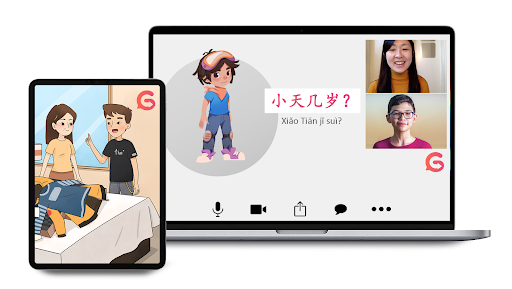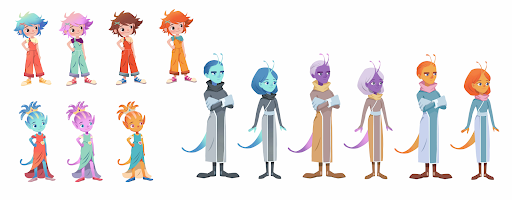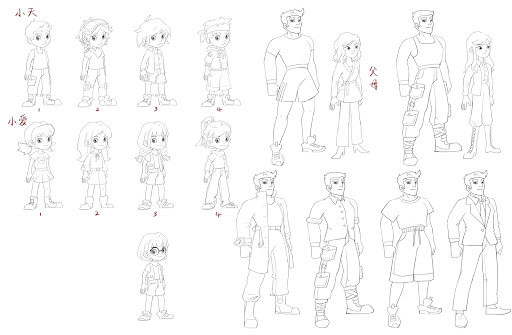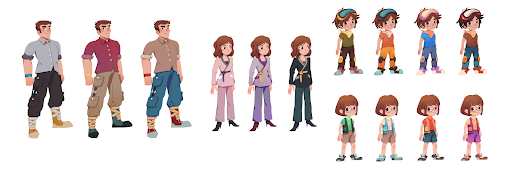Since 2012, GoEast Mandarin has taught the Chinese language to non-Chinese students, whether on its campus or online — on all language levels, to children as well as adults. We sat down with Lily who heads curriculum design for the online Chinese courses for children, as well as Ying, who provides those Chinese courses with custom illustrations.
GoEast’s courses for children
In GoEast’s courses, children learn the Chinese language through conversation, games, puzzles, and activities — acquiring an intuitive feeling for the language rather than learning it the way adults do, for instance consciously learning the Chinese grammar rules. Classes are purposely designed to engage kids & teens, based on constant feedback cycles with teachers and looking at the exam results of children, as well as academic theory. The courses (including the adult ones) have been rated 4.7 on Trustpilot.
We ask Lily Li, the main curriculum designer for GoEast Mandarin’s online children courses, five questions.
1) How do you design a curriculum for children?
At the beginning in 2014, we did a lot of research, reading a lot of existing materials and books like Easy-Steps to Chinese, 快乐汉语, and how the YCT (Youth Chinese Test) is examined. The most important thing is getting an idea of the Chinese vocabulary and grammar requirements of each level that children need to learn.
After that, we decided what kind of Chinese course for children we wanted to make. A video course, or a more-story driven course?
Both have benefits, but ultimately we decided on a more-story driven course, for several reasons. Video courses are less easy to change, plus less suitable for kids because live classes are better to retain children’s attention. It’s also GoEast Mandarin’s biggest strength in its course for adults: just the teaching quality.
After that, we researched what kind of story children in the age range of 5 to 12 like, also split down per region. We interviewed lots of students & parents to find out what helps. An example of a course-long story is a family that moves from the US to China and travels to all kinds of cities in China to discover food, customs, and history. Children can really immerse in that while learning Chinese.
Then earlier this year we researched other topics children like also, and we came up with a new adventure & fantasy story, with a cute alien girl Mika (米卡) who comes to Earth, specifically to China, to make notes on how we humans live. And through that, she (and the student) learns the Chinese language.
2) What are things you do differently for kids rather than adults?
Chinese courses for children we purposely make more fun. We need to prepare a lot of games to attract their attention.
Then there is also the difference in how for instance grammar is taught. We follow the YCT standards for introducing specific grammars at certain language levels. But we don’t teach Chinese grammar rules very obviously, we rather replace words in a sample sentence and let children recite the sentence for their own situation. We don’t say ‘Oh this is grammar’ or instruct how to use this grammar like we’d teach adults Chinese.
Then some words are shifted because they’re more important for children, for instance, children learn about clothes or sports much earlier than adults, but adults learn terms about the economy or working in an office.
3) How do you know what works (in the class) and what doesn’t?
From the YCT standards, we know what level they need to finish, and we test our students either through exams or games which are exams in disguise. So we make sure that children can achieve their learning goals that fit their level through our Chinese online courses.
That is one part. The other part is whether they like the classes and are motivated to learn. For this we look at recorded classes for training purposes, we interview parents and ask kids what they think of the teacher, curriculum, and the lesson as a whole.
There is also teacher feedback because teachers know very well what works and what doesn’t. If you don’t pay attention to it, language learning can be a bit tedious. So we add lots of games so it feels like playing. We use the story to acquire new words: if you want to learn the story you need to discover those new words.
4) How do you instruct the Chinese online teachers?
Teachers are probably the most important aspect of the whole Chinese online course for children, because they both educate the children, but also need to engage them. Yet most teachers aren’t involved in the development of the curriculum so we give them training on how to teach Chinese online to children. Quite extensively. You could say we teach adults and children Chinese, and we’re a training institute for teachers too, teaching them how to teach Chinese.
So for teachers, we introduce the curriculum to them and make them understand each level with the corresponding grammar, words, and conversations. We will show a demo class, and our overarching principles, for example, two very important ones:
- A teacher cannot use a lot of English and should speak as much Chinese as possible, corresponding to the level of the student.
- A teacher should mostly let the student speak and create opportunities for him or her to speak.
But this is a two-way process. The teachers also give input. We will have weekly feedback meetings about how to improve our materials, maybe the games aren’t suitable or there are too many or few words in a certain presentation. Then we will adjust the course part, or shift content.
About the illustrations for GoEast’s Chinese course for children
Ying: “I’ve been drawing since I was a child myself, and now I have made it my work. I like a lot of different styles, cartoonish or more fantasy, loads or little use of color. I take inspiration from movies, or the beautiful scenery in my hometown Zhengzhou, and all the interesting things I encounter in my life.
I draw digitally with a Wacom tablet in Photoshop, and creating the characters for GoEast together with the team, so that they fit in the story of Xiao Tian (小天) and Mika (米卡).”
Lily: “Actually many parents have complimented us on the illustration quality. Children don’t spontaneously say it, but I think they also like this part of the Chinese courses.”
For more information on GoEast Mandarin’s online Chinese courses for children, see their website:
https://goeastmandarin.com/online-chinese-for-children/
For a demo class, see this video of Gideon with Jenny老师:
- Peking University Application Guide 2025 - October 25, 2024
- Jiangsu University MBBS: Now Open for Spring 2025 Intake - October 12, 2024
- ZUST 2025 Admissions Guide, Deadlines, and Scholarship - October 10, 2024







